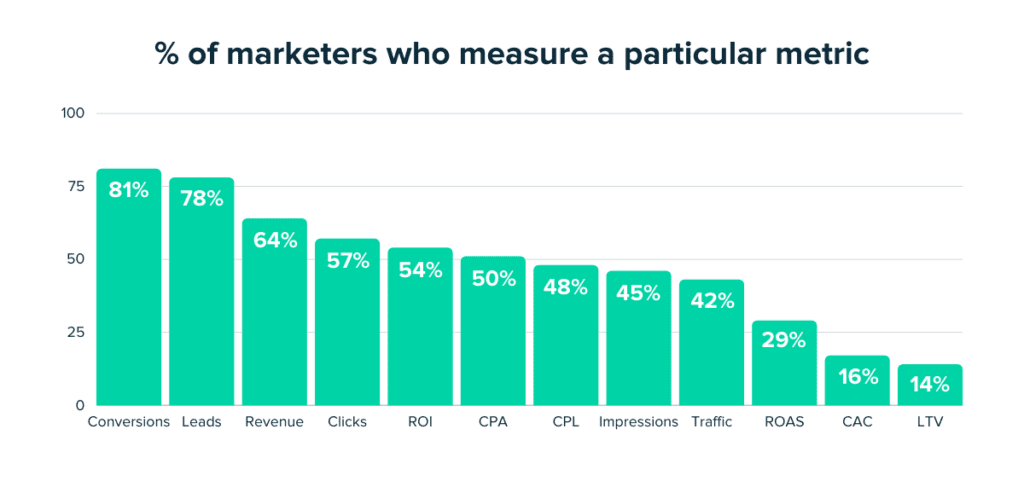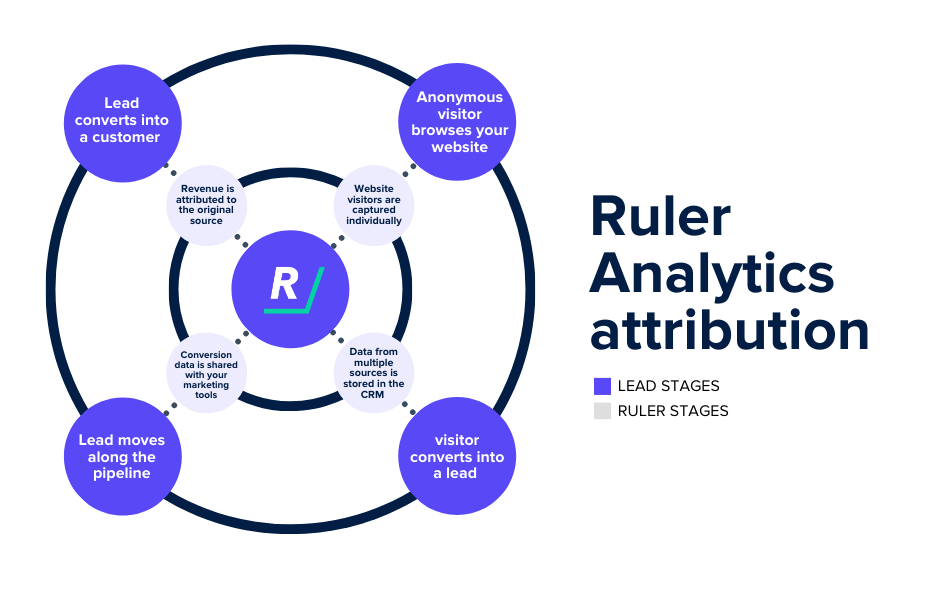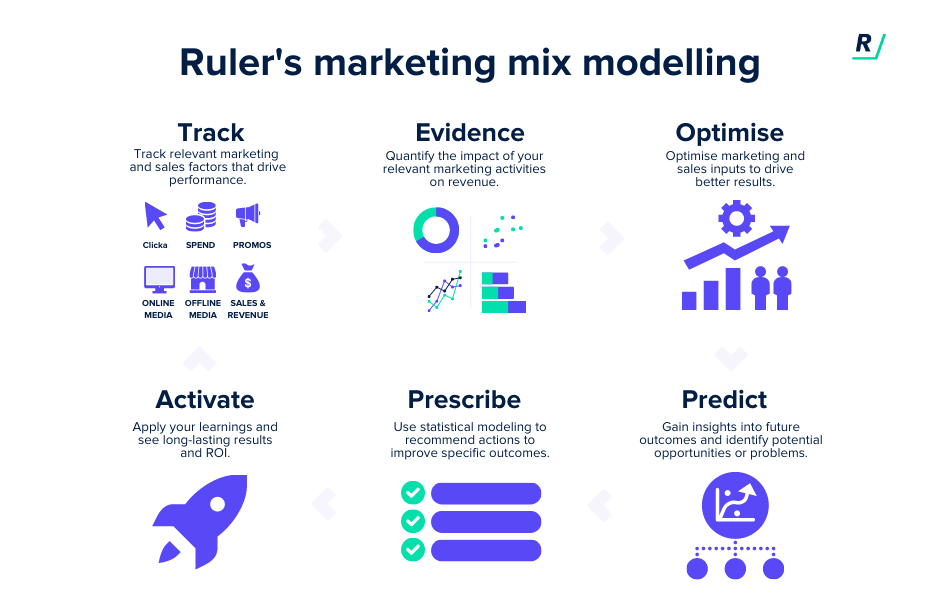Measure your success and prove your impact with the right marketing metrics.
Marketing metrics are essential for guiding organisations towards success. They provide insights into what is and is not working and help marketers make informed decisions about how to allocate their resources more effectively.
But with so many metrics to track, it’s easy to lose sight of what’s important. In fact, our study found that only 23% of marketers are confident they’re tracking the right metrics.
To help marketers gain more confidence in their reporting, we reached out to experts to compile a list of the most valuable metrics to measure marketing effectiveness.
Here’s what we’ll discuss:
💡 Pro Tip
Marketing measurement can be challenging, but tools like Ruler make it much easier. Ruler is an attribution and MMM tool that attributes revenue back to your marketing touchpoints across multiple sessions and sources. Don’t let your marketing efforts go unmeasured. Book a demo and see how Ruler can prove the value of your marketing campaigns.
Get your free demo of Ruler
A marketing metric is a quantifiable measure that is used to track the performance of a marketing campaign or activity. Marketing metrics can be used to measure a variety of things, such as website traffic, lead generation, sales, and return on investment (ROI).
By tracking marketing metrics, marketers can gain valuable insights into the effectiveness of their campaigns and make informed decisions about how to improve them.
For example, if a marketer tracks website traffic and sees that it is declining, they can investigate the reasons for the decline and make changes to their website or marketing campaigns to improve traffic.
There are tons of metrics that marketers can track to measure campaign success. Traffic, conversions, leads—the list goes on.
It’s important to track metrics that prove your efforts are working, but what are the best metrics for indicating marketing effectiveness?
Over 200 marketers pitched in for our attribution and reporting analysis survey and submitted top key performance indicators for tracking campaign and marketing performance.

A conversion occurs when an individual completes a desired goal, such as filling out a form, making a phone call or downloading a whitepaper.
“Conversions are the most important metric to track because they bring tangible value to the client. If your website isn’t converting to your goals, your client isn’t going to feel the effects of your efforts or get a good ROI,” says Matt Benevento, Senior SEO Strategist at HMG Creative.
Put simply, a lead is any person who shows interest in a company’s product or service.

“Leads, or lead generation, is the most important indicator of marketing campaign success since a customer’s purchase generates revenue. This is tracked through contact form submissions, phone calls, and appointment requests,” says Brandon Schroth, Co-Founder at Nomad SEO.
Revenue is the amount of money you generate by selling your product and services. Tracking revenue is crucial as it essentially demonstrates the velocity of your business growth.
“We are primarily tracking our return on investment and monthly recurring revenue metrics, as these are most important for our current business goals. Larger businesses may not care about the initial ROI of their marketing campaigns, but fresh brands like ours do. The monthly recurring revenue metric is a good way to see whether or not your marketing efforts are working,” says Eric Mills, Owner & CEO at Pro Support Accessories.
Revenue is one of the most important metrics to track, but it’s not easy. Several factors prevent marketers from attributing revenue to marketing:
To overcome these limitations, marketing teams are turning to multi-level measurement tools to help understand which marketing sources are most responsible for driving conversions and revenue.
Take Ruler, for example. Ruler takes the best of multi-touch attribution and marketing mix modelling to help you better understand your marketing performance and identify areas to prioritise.
Ruler’s multi-touch attribution tracks your customer journeys using first-party data. It captures marketing sources, page views, UTM variables, and cookie IDs. When a lead converts, Ruler sends everything it has collected to your CRM and enriches your leads and opportunities with marketing source data.
When a lead is marked as closed as won, the revenue data is sent back to Ruler. With revenue and opportunity data in Ruler, you can easily measure and validate the impact of your marketing sources, campaigns and keywords.

Ruler’s marketing mix modelling, on the other hand, takes care of your invisible touchpoints (ad impressions and offline media. A good example would be when a user is served an ad, and then instead of clicking, they go directly to your website to convert into a lead or customer.
It shows how your offline media and invisible touchpoints impact revenue and projects how much headroom is still left in your advertising channels.

💡 Pro Tip
We have plenty more on Ruler and how it attributes revenue to your marketing. If you want to see it in action, book a demo and see how Ruler can justify your costs and prove your ROI by attributing revenue back to your marketing sources.
Get your free demo here
Clicks are used to count the number of times that users click on an ad or piece of content that directs them to a specific destination i.e. a landing page on your website.
Acquisition Manager at Tidio, Karol Nowacki, believes: “Click-through rate is one of the fundamental marketing metrics.”
Karol added, “It shows us straightforwardly whether we reach our targeted audience and stand out through the competitors. For example, low CTR may suggest that our target group ignored our campaign or didn’t find it interesting enough to click.
Demonstrating ROI across your channels, campaigns, and ads is essential. Without it, you’re marketing blind.
“ROI is used to determine which investments are more profitable and efficient than others. It’s especially helpful when comparing different business units within an organisation,” says Business Growth Strategist Danny Veiga.
Related: How to measure digital marketing ROI
Danny continues: “ROI may also give you insight into how much profit each potential project at work would offer based on its expected rate of return while accounting only for current cost.”
Cost per acquisition is a metric that measures your advertising cost by a conversion, as opposed to a click. This can include downloading content, filling a form, or making a purchase.
Related: What is cost per acquisition

“Cost per acquisition is useful for businesses as it allows you to compare the ROI from different campaigns as well as figure out how much it costs you to acquire a customer,” says Alex Moss, Founder & CEO at Tactical Arbitrage.
Cost per lead is a marketing metric used to determine how well your campaigns are working to drive new leads. To calculate CPL, you just take your total marketing spend and divide it by the total number of new leads.
While this metric offers some value, CPL only takes you so far. A lead doesn’t guarantee revenue. So, always be aware that your investment for each lead might not ever result in revenue.
Related: Cost per lead—how effective is your marketing?
“CPL is solely concerned with the campaign’s lead generation. It does not assess the quality of leads because it excludes the sales process. Let’s imagine the five sales came from ten leads in the previous example. With the same $1,000 budget, that equates to a lead cost of $100,” Amit Raj, Founder at The Links Guy.
Impressions show you how many times your ad or content has been viewed by your target audience.
If you’re growing brand awareness, it’s vital to understand how many people you’re reaching. Engagements and impressions on an individual post-by-post basis is a great way to learn what content is working.
💡 Quick reminder
Impressions are easy to count, but linking impressions to revenue is tough. Don’t forget Ruler’s MMM can provide a solution to this problem. It takes your invisible touchpoints into account (including impressions), allowing you to see which marketing channels are most effective at driving revenue and to optimise their campaigns accordingly. Click the link to learn more about Ruler’s marketing mix modelling.
“Traffic is one of the most essential metrics to track, and that includes differentiating between organic and paid traffic,” says Kristaps Brencans, CMO at On The Map.

Kristaps added: “One of the main goals of any marketing campaign is to bring more visitors to your website, which is the hub of your business, and traffic is the best measure of that success rate.”
“ROI can be substituted by ROAS if the primary source that generates the most leads for your business is PPC,” says Evgenia Evseeva, SEO Manager at Brand North.
An acronym for return on ad spend, ROAS is primarily used by PPC marketers to understand how adverts are driving conversions and sales for their businesses.
Related: Why return on ad spend is important and how to track it
ROAS is crucial as it allows you to determine which ad campaigns are most and least successful so you can continuously refine your spending to generate the most revenue for the least costs.
Customer acquisition cost is the average amount of money that a business spends to acquire new customers.
When tracked correctly, marketers can gain insight into the acquisition channels that generate the most value and allocate budgets accordingly to drive more profitable results.

Martin Luenendonk, CEO at FounderJar, agrees: “This metric lets you know the total cost of gaining a new customer. Knowing how much it costs to acquire customers can help you make better marketing decisions and allocate marketing resources well.”
Customer lifetime value indicates the total revenue a business can expect from a single customer. It’s a must have metric for SaaS companies and service-based businesses that provide a monthly retainer.
Related: How to calculate customer lifetime value
With customer lifetime value, you can effectively decide how much you need to spend to acquire new customers.
If your customer acquisition cost is higher than your customer value, there’s a strong possibility that you’re losing money.
“By calculating the CLV, you can identify which marketing initiatives bring in the most clients,” added Saskia Ketzm CEO at MojomoX.
As we’ve just discussed, there’s a plethora of KPIs that you can choose from to track the effectiveness of your campaigns.
But, by tracking the marketing KPIs that matter, you can make important decisions that will help drive your business forward.
Bradley Bonnen, Founder & CEO at iFlooded Restoration, agrees: “Having the right metrics to measure your strategy can help you make sense of the data and make necessary improvements.”
Seeing as every business is unique, you can’t rely on a guide to tell you what you should or shouldn’t be measuring.
However, there are things you can take into consideration when attempting to choose and manage the right KPIs for your business.
When used properly, metrics are an extremely effective way to gauge the impact of your marketing campaigns.
The most effective metrics are closely tied to wider business objectives and answer critical questions asked by your company executives and clients.
More importantly, they provide you with a better understanding of your outputs, allowing you to drive more meaningful actions across your marketing campaigns. Before you choose your metrics, it helps to know what objectives you’re performing against.
Start with the basics:
Darshan Somashekar, Founder at Freecell Challenge, agrees: “The objective is to match your KPIs to your company goals, focusing on those that have a direct impact on business outcomes.”
You can measure an abundance of different, yet equally detailed metrics such as visits, clicks, and conversions. But in spite of this profusion of choice, think about how many you definitely need.
Less is more when it comes to KPIs.
If you try to track too many KPIs all at once, you can end up counteracting your performance efforts. Therefore, as a rule of thumb, you should avoid tracking more than 10 KPIs at a time.
Viewing metrics in isolation can lead to false conclusions and poor decision-making.
For example, your campaign may do well in driving leads, but when you dig in, you might find that these leads are not ready to buy or unqualified.
Your sales team suffers because marketing isn’t doing its job to drive the right type of leads and negatively impacts their own specific metrics and goals.
If you were to look at your metrics holistically, however, you could ensure that your marketing team is successful in driving qualified leads whilst maximising the bottom line.
Content Marketer at GoodFirms, Nathan Sebastian, agrees: “Looking at any of the campaign insights in isolation can be misleading. For example, tracking the number of likes or favourites on a piece of content will simply make one aspect of the campaign’s engagement more visible.”
Nathan continues: “As such, this won’t reveal whether the target audience also acted or reacted in other ways which are potentially more valuable.
This could include commenting, sharing or signing up for further information with a valid email address. You need to look at metrics together to get a holistic view of effectiveness and performance.
Different companies use different reporting methods. For most businesses, however, there’s only one person in charge of producing marketing reports.
Everyone thinks differently when reporting on marketing effectiveness. Having one person in charge keeps your marketing consistent and accurate to ensure everything runs without a hitch.
Founder & CEO at Wall Street Zen, Nate Tsang, suggests: “Designating one person to gather data for a detailed report that you can review together.”

Nate continues: “You can review what went wrong and right, then start over again.”
Marketing metrics are invaluable for measuring and optimising the effectiveness of your marketing efforts.
With the right metrics, you can gain valuable insights into customer behaviour, campaign performance, and overall ROI.
Don’t forget, with tools like Ruler, tracking your metrics is a breeze.
Got any questions about Ruler? Ping me on LinkedIn. Or book a to see how it can help you track your metrics and prove the impact of your marketing campaigns.
